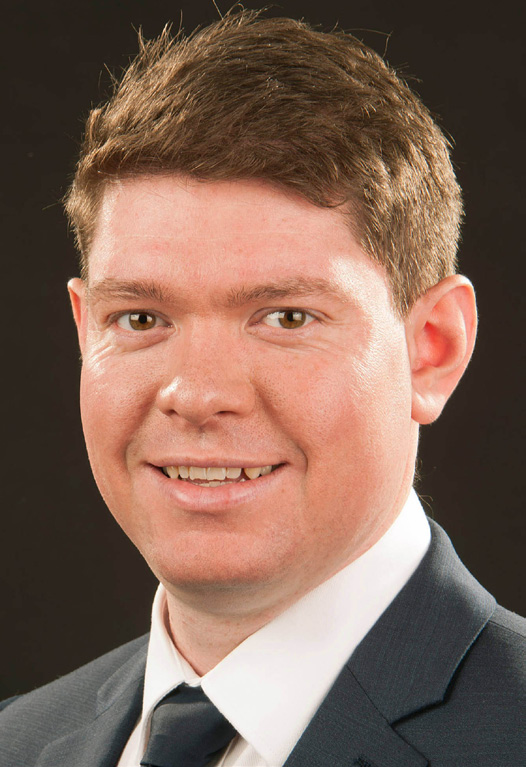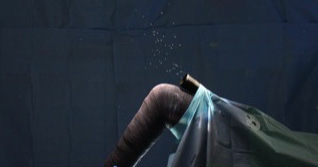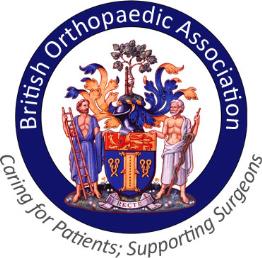Boa.ac.uk



Volume 03 / Issue 03 / September 2015 boa.ac.uk
Page 50
JTO Peer-Reviewed Articles
Prevention of
Ramsay Refaie, Simon Jameson and Mike Reed
The Basis of the
Periprosthetic joint infection (PJI) can be a catastrophic
When Charnley wrote about
complication fol owing joint replacement surgery. The financial
prosthetic joint infection in 1969 he stated there was "still
costs and morbidity associated with PJI are wel established1-3
uncertainty as to how often
with evidence now emerging that PJI is an independent risk
a wound is infected in the operating room and how often
factor for mortality4. Prevention is better than cure and whilst an at a later date during the healing
exhaustive list is beyond the scope of this article we wil discuss
of the wound"5. This same uncertainty still persists to this
some offbeat tactics to consider in practice.
day. Contaminants may arise from the patient's skin, from the surgical personnel or from the surgical instrumentation itself 6, 7. It is likely that almost all surgical wounds are contaminated because skin preparation at the time of surgery will only decontaminate the skin surface and bacteria will remain in deeper layers of the skin8. Whilst it is also possible for infection to seed to the implant in haematogenous spread or so called "metastatic infection"9 this occurs less frequently. Gram-positive organisms are the most commonly reported with Staphylococcus aureus
accounting for over a third of reported PJIs in England and Wales10.
Broadly speaking prevention strategies target modifiable patient factors and peri-operative factors; these are summarised in Table 1. Many of these tactics are presented at open events with The Quality Improvement in
Ramsay Refaie
Simon Jameson
Surgical Teams initiative11.
Volume 03 / Issue 03 / September 2015 boa.ac.uk
Page 51
2015 British Orthopaedic Association
Journal of Trauma and Orthopaedics: Volume 03, Issue 03, pages 50-52
Title: Prevention of Periprosthetic Joint Infection
Authors: Ramsay Refaie, Simon Jameson and Mike Reed
Risk Factor
Proven strategies and
5% (p<0.001) in patients undergoing
some food for thought
hip and knee arthroplasty17. Smoking cessation should be
considered for al patients.
• Disease-modifying anti-rheumatic drugs
MSSA screening and
(DMARDs) including methotrexate should be
Patient warming
discussed with the prescriber
• Peri-operative steroids are general y not required
Methicil in Resistant
Pre warming of patients before
• Balance the risks and benefits of stopping anti-
Staphylococcus aureus (MRSA)
theatre is a proven strategy for
TNF – stop at 3-5 half-lives pre-operatively, restart
is the emotive "superbug" that
preventing hypothermia intra-
after wound healing and no evidence of infection
every patient seems to fear.
operatively and in recovery18, 19.
Indeed MRSA infections have
A large RCT from the UK published
• Dietician input to encourage weight loss
been shown to have significantly
in the Lancet showed that pre
• Adjust peri-operative antibiotic doses appropriately
higher treatment costs than other
warming reduced the risk of infection
• In super-obese consider bariatric surgery prior to
causal organisms of PJI12. MRSA
by around 65% in clean surgery20.
joint replacement surgery
screening is now wel established
Despite this pre warming is stil not
• Consider a smoking cessation programme
across the NHS with positive
widely adopted in UK centres.
results prompting decolonisation
• Screening based on local guidelines, and
prior to surgery. However, nasal
Intra-operative warming is widely
decolonise prior to surgery
carriage of Methicil in sensitive
performed but the method of
Methicil in Sensitive
organisms (MSSA) also confers
intra-operative patient warming
an increased risk of PJI. Carriage
may also alter the risk of infection
is common ( 20%)13 and
during clean air surgery21.
decolonisation presents us with
Randomised studies have
an easy "high yield" strategy in
demonstrated that the popular
the fight against PJI. A large,
forced air warming devices interact
Patient preparation
• Shower on day of surgery
randomised, placebo control ed
with laminar air flow currents in
• If hair removal required, use electric clippers on
multi-centre trial published in the
such a way that non-filtered air can
New England Journal of Medicine
be drawn from outside the clean
• Avoid oil-based skin moisturisers
in 2010 showed that decolonisation
air canopy into the wound area22, 23.
of MSSA carriers with mupirocin
Our own switch to the alternative
• Prophylactic antibiotics should be given as early
nasal ointment and chlorhexidine
conductive fabric warming led
as possible in the anaesthetic room
soap prior to orthopaedic and
to a significant decrease in deep
• If cementation is required, antibiotic-impregnated
cardiothoracic surgery reduced
infection rates22. These concepts
cement should be used
their risk of MSSA SSI by almost
are best demonstrated in high
• There is little consensus or evidence for which
60% from 7.7% to 3.4%13. This
definition video (www.youtube.
antibiotic prophylaxis
strategy has also been shown to be
• Use laminar flow where possible
cost effective14. Despite this, many
• Keep theatre door opening to a minimum
centres stil do not routinely screen
Laminar flow and lights
for MSSA. After MSSA screening
• Hand wash with antiseptic surgical solution,
and decolonisation was introduced
Historical evidence has shown
using a single-use brush or pick for the nails
in one NHS joint replacement
that laminar flow in combination
• Before subsequent operations hands should be
unit, MSSA infections reduced
with antibiotic prophylaxis
washed with either an alcoholic hand rub or an
from 0.84% to 0.26% - the caveat
reduces infection rates in joint
antiseptic surgical solution
being there were other infection
arthroplasty24. Recently however,
• Use scrub staff assisted glove donning
prevention methods implemented
the benefit of laminar flow has
• Double glove and change gloves regularly
during the time period15.
come into question10, 25, 26.
• Use an alcohol pre-wash fol owed by a 2%
chlorhexidine-alcohol scrub solution, or alcoholic
Given the fragile nature of laminar
betadine. Beware of fires
air flow, we wanted to investigate
Smokers are at increased risk
the impact of popular suspended
• Maintain normothermia
of wound complications and
theatre lights. In a series of
• Maintain normovolaemia
infections16. A randomised
experiments using neutral y buoyant
• A higher inspired oxygen concentration peri-
control ed trial from Denmark,
helium bubbles we evaluated the
operatively and for 6 hours post-operative may
published in the Lancet, has shown
efficacy of laminar flow at clearing
that cessation or at least 50%
particles from the operative field
reduction in smoking decreased
looking specifical y at the impact
Table 1: Summary table of common prevention tactics
wound complications from 31% to
of lights. These experiments


Volume 03 / Issue 03 / September 2015 boa.ac.uk
Page 52
JTO Peer-Reviewed Articles
are best viewed in high definition
orthopodresearch). Perhaps
PJI is catastrophic and every
unsurprisingly we found that placing
feasible step should be taken to
lights directly above the operative
prevent this. Whilst this article is
field impairs the ability of the system
not exhaustive it may encourage
to clear airborne particles. Figure
achievable strategies to reduce
1 shows the rate at which particles
the incidence of PJI.
were cleared from the operative field after one minute of fil ing with
Ramsay Refaie is a Specialty
bubbles. No lights, a single light
Trainee in the Northern Deanery.
and two lights over a mannequin
He is currently on an out of
knee (Figure 2) were evaluated.
program experience for research at
This provides further evidence for
Newcastle University and is looking
the intuitive interactions between
Figure 1: Rate of bubble clearance
at novel diagnostic biomarkers in
laminar air flow currents and objects
Prosthetic joint infection.
within it. Based on this the lead author has joined several others who
Simon Jameson is currently Robin
operate without suspended theatre
Ling Hip Fellow at the Princess
lights for knee replacement. Hugh
Elizabeth Orthopaedic Centre in
Howorth and Sir John Charnley
Exeter. He trained on the Northern
worked closely to develop the
and Glasgow Orthopaedic
optimal operating environment.
rotations. He is a past NJR
The original greenhouse used by
research fellow with an MD
Charnley contained two banks of
thesis focused on outcomes after
lights to il uminate the operative
primary hip replacement.
field27. Subsequent Howorth/Charnley theatre designs contained
Mike Reed is an orthopaedic
banks of lights outside the laminar
surgeon for Northumbria
flow canopy. The theatre picture
Healthcare and a Senior Lecturer
Figure 2: Knee mannequin with bubbles being introduced
of Wrightington Hospital (Figure
with Newcastle University. He
3) clearly shows a bank of lights
Chairs the Trust's Surgical Site
outside the laminar flow enclosure.
Infection Prevention Programme.
Whilst this approach is not for everyone, an awareness of the potential interactions with laminar
flow and attempts to minimise these should be encouraged.
Targeted antibiotic
The benefits of prophylactic
antibiotics are widely accepted across most surgical specialties28, 29.
References can be found online at
Figure 3: Old Theatre 1 at Wrightington Hospital
Prophylaxis is however not without
risks and the potential reduction
or by scanning the QR Code.
in SSIs must be balanced against
in elective orthopaedic surgery
with higher incidence of acute
the adverse effects of antibiotics.
(1.7 per 1000)30. A systematic
kidney injury and no change
Cephalosporins, once a panacea in
review reported that there is
in rates of PJI32-35. Elsewhere,
our prophylactic armamentarium,
insufficient evidence of a
gentamicin alone has also been
have fallen out of favour in the UK
significant difference between
shown to offer no benefit in terms
largely due to their association with
cephalosporins, teicoplanin or
of reducing CDAD36. With all this
Clostridium difficile associated
penicillin derivatives31. In practice,
confusion a large randomised trial
diarrhoea (CDAD), despite this
most prophylactic regimens are
is required to best protect our
representing a relatively minor
now based on dual therapy yet
patients undergoing primary joint
these are frequently associated

References
1.
Darouiche, R.O., Treatment of infections associated with surgical implants. N Engl J Med, 2004. 350(14): p.
1422-9.
Edwards, C., et al., Early infection after hip fracture surgery: risk factors, costs and outcome. J Bone Joint Surg
Br, 2008. 90(6): p. 770-7.
Bozic, K.J. and M.D. Ries, The impact of infection after total hip arthroplasty on hospital and surgeon resource
utilization. J Bone Joint Surg Am, 2005. 87(8): p. 1746-51.
Zmistowski, B., et al., Periprosthetic joint infection increases the risk of one-year mortality. J Bone Joint Surg
Am, 2013. 95(24): p. 2177-84.
Charnley, J. and N. Eftekhar, Postoperative infection in total prosthetic replacement arthroplasty of the hip-
joint. With special reference to the bacterial content of the air of the operating room. Br J Surg, 1969. 56(9):
p. 641-9.
Albrich, W.C. and S. Harbarth, Health-care workers: source, vector, or victim of MRSA? Lancet Infect Dis,
2008. 8(5): p. 289-301.
Hughes, S.P. and F.M. Anderson, Infection in the operating room. J Bone Joint Surg Br, 1999. 81(5): p. 754-5.
Charnley, J., Postoperative infection after total hip replacement with special reference to air contamination in
the operating room. Clin Orthop Relat Res, 1972. 87: p. 167-87.
Hunter, G. and D. Dandy, The natural history of the patient with an infected total hip replacement. J Bone
Joint Surg Br, 1977. 59(3): p. 293-7.
Brandt, C., et al., Operating room ventilation with laminar airflow shows no protective effect on the surgical
site infection rate in orthopedic and abdominal surgery. Ann Surg, 2008. 248(5): p. 695-700.
Quality Improvement in Surgical Teams Initiative. [cited 2015 1st June]; Available from:
Parvizi, J., et al., Periprosthetic joint infection: the economic impact of methicillin-resistant infections. J
Arthroplasty, 2010. 25(6 Suppl): p. 103-7.
Bode, L.G., et al., Preventing surgical-site infections in nasal carriers of Staphylococcus aureus. N Engl J Med,
2010. 362(1): p. 9-17.
van Rijen, M.M., et al., Reduced costs for Staphylococcus aureus carriers treated prophylactically with
mupirocin and chlorhexidine in cardiothoracic and orthopaedic surgery. PLoS One, 2012. 7(8): p. e43065.
Malviya, A., Email to Ramsay Refaie re. infection rates at Northumbria Healthcare following introduction of MSSA decolonisation. 2015.
Kwiatkowski, T.C., E.N. Hanley, Jr., and W.K. Ramp, Cigarette smoking and its orthopedic consequences. Am J
Orthop (Belle Mead NJ), 1996. 25(9): p. 590-7.
Moller, A.M., et al., Effect of preoperative smoking intervention on postoperative complications: a
randomised clinical trial. Lancet, 2002. 359(9301): p. 114-7.
van der Horst, M., et al., Preoperative warming reduces the incidence of hypothermia in total hip‐ and knee
replacement surgery under spinal anesthesia: 1AP1–2. European Journal of Anaesthesiology (EJA), 2010.
27(47): p. 7.
Just, B., et al., Prevention of intraoperative hypothermia by preoperative skin-surface warming.
Anesthesiology, 1993. 79(2): p. 214-8.
Melling, A.C., et al., Effects of preoperative warming on the incidence of wound infection after clean surgery:
a randomised controlled trial. Lancet, 2001. 358(9285): p. 876-80.
Wood, A.M., et al., Infection control hazards associated with the use of forced-air warming in operating
theatres. J Hosp Infect, 2014. 88(3): p. 132-40.
McGovern, P.D., et al., Forced-air warming and ultra-clean ventilation do not mix: an investigation of theatre
ventilation, patient warming and joint replacement infection in orthopaedics. J Bone Joint Surg Br, 2011.
93(11): p. 1537-44.
Legg, A.J. and A.J. Hamer, Forced-air patient warming blankets disrupt unidirectional airflow. Bone Joint J,
2013. 95-B(3): p. 407-10.
Lidwell, O.M., et al., Ultraclean air and antibiotics for prevention of postoperative infection. A multicenter
study of 8,052 joint replacement operations. Acta Orthop Scand, 1987. 58(1): p. 4-13.
Hooper, G.J., et al., Does the use of laminar flow and space suits reduce early deep infection after total hip
and knee replacement?: the ten-year results of the New Zealand Joint Registry. J Bone Joint Surg Br, 2011.
93(1): p. 85-90.
Zheng, H., et al., Control strategies to prevent total hip replacement-related infections: a systematic review
and mixed treatment comparison. BMJ Open, 2014. 4(3): p. e003978.
Parkin, A., Pioneer Surgeon Drove Ultra Clean Technology. Health Estate, 2013. 1.
Classen, D.C., et al., The timing of prophylactic administration of antibiotics and the risk of surgical-wound
infection. N Engl J Med, 1992. 326(5): p. 281-6.
Prokuski, L., et al., Prophylactic antibiotics in orthopaedic surgery. Instr Course Lect, 2011. 60: p. 545-55.
Jenkins, P.J., et al., Clostridium difficile in patients undergoing primary hip and knee replacement. J Bone Joint
Surg Br, 2010. 92(7): p. 994-8.
AlBuhairan, B., D. Hind, and A. Hutchinson, Antibiotic prophylaxis for wound infections in total joint
arthroplasty: a systematic review. J Bone Joint Surg Br, 2008. 90(7): p. 915-9.
Challagundla, S.R., et al., Renal impairment after high-dose flucloxacillin and single-dose gentamicin
prophylaxis in patients undergoing elective hip and knee replacement. Nephrol Dial Transplant, 2013. 28(3):
p. 612-9.
Ross, A.D., et al., Peri-operative renal morbidity secondary to gentamicin and flucloxacillin chemoprophylaxis
for hip and knee arthroplasty. Scott Med J, 2013. 58(4): p. 209-12.
Bailey, O., et al., Antibiotic-related acute kidney injury in patients undergoing elective joint replacement.
Bone Joint J, 2014. 96-B(3): p. 395-8.
Craxford, S., E. Bayley, and M. Needoff, Antibiotic-associated complications following lower limb
arthroplasty: a comparison of two prophylactic regimes. Eur J Orthop Surg Traumatol, 2014. 24(4): p. 539-43.
Sprowson, A., et al., Changing antibiotic prophylaxis for primary joint arthroplasty affects postoperative
complication rates and bacterial spectrum. Surgeon, 2013. 11(1): p. 20-4.
Source: https://www.boa.ac.uk/wp-content/uploads/2015/08/Prevention-of-Periprosthetic-Joint-Infection.pdf
MONOGRAPHIE DE PRODUIT PrTRINTELLIXMC Vortioxétine (sous forme de bromhydrate de vortioxétine) Comprimés dosés à 5, 10 et 20 mg Lundbeck Canada Inc. Date de rédaction : 1000, rue De La Gauchetière Ouest, Montréal (Québec) Numéro de contrôle de la présentation : 159019 Monographie de TRINTELLIX Page 1 de 46
2015 Comprehensive Formulary HeartlandPlains Health 2015 Formulary List of Covered Drugs PLEASE READ: THIS DOCUMENT CONTAINS INFORMATION ABOUT THE DRUGS WE COVER IN THIS PLAN We have made no changes to this formulary since 10/15/15. For more recent information or other questions, please contact HeartlandPlains Health (HMO) Customer Service, at 1-866-792-0184or, for TTY users, 711, 8:00 am to 8:00 pm, Monday-Friday and 8:00 am to 8:00 pm, Monday-Sunday October 1 through February 14, or visit www.HeartlandPlainsHealth.com.






